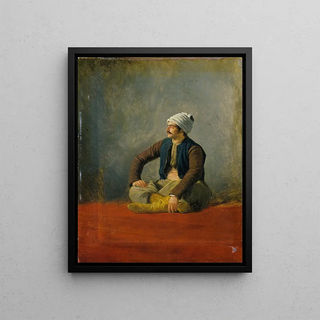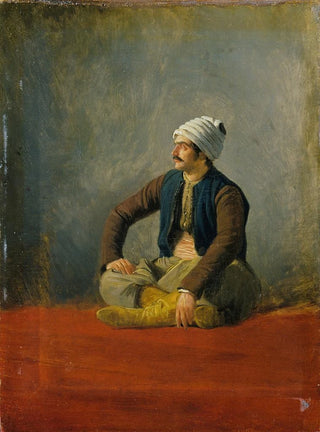Art print | An Eastern merchant - Horace Vernet


View from behind

Frame (optional)
In the vibrant universe of 19th-century painting, Horace Vernet's "A Merchant of the East" stands out for its lively atmosphere and captivating visual storytelling. This canvas, which evokes commerce and cultural exchanges, transports the viewer to a world where the Orient and the Occident meet with palpable intensity. Vernet, master of narrative painting, succeeds in capturing not only the intricate details of daily life but also the very essence of the characters he depicts. Through this work, he invites us to explore the subtleties of human relationships and social dynamics at the heart of a thriving trade.
Style and uniqueness of the work
The piece is characterized by a style that combines realism and romanticism, an artistic signature of Horace Vernet. The colors, rich and shimmering, confer exceptional depth to the scene, while light plays a crucial role in highlighting the faces and gestures of the characters. Every detail, whether traditional clothing or exchanged objects, is carefully rendered, demonstrating the artist's concern for historical authenticity. The composition, meanwhile, is skillfully orchestrated, with a dynamic that guides the eye across the painting, gradually revealing the interactions between the protagonists. This play of looks and gestures creates a visual narration that immerses the viewer in a story full of emotion and meaning.
The artist and his influence
Horace Vernet, born in 1789, was a French painter whose work was marked by a deep fascination with the oriental world and adventure stories. Son of the famous painter Carle Vernet, he developed a style that was uniquely his own, blending sharp observation of reality with romantic sensitivity. Vernet traveled across Europe and the Orient, his experiences enriching his art and worldview. His influence is evident in the development of the history painting genre, where he combined narrative elements with realistic representation. Through "A Merchant of the East," he echoes a time when cultural exchanges were flourishing.

Matte finish

View from behind

Frame (optional)
In the vibrant universe of 19th-century painting, Horace Vernet's "A Merchant of the East" stands out for its lively atmosphere and captivating visual storytelling. This canvas, which evokes commerce and cultural exchanges, transports the viewer to a world where the Orient and the Occident meet with palpable intensity. Vernet, master of narrative painting, succeeds in capturing not only the intricate details of daily life but also the very essence of the characters he depicts. Through this work, he invites us to explore the subtleties of human relationships and social dynamics at the heart of a thriving trade.
Style and uniqueness of the work
The piece is characterized by a style that combines realism and romanticism, an artistic signature of Horace Vernet. The colors, rich and shimmering, confer exceptional depth to the scene, while light plays a crucial role in highlighting the faces and gestures of the characters. Every detail, whether traditional clothing or exchanged objects, is carefully rendered, demonstrating the artist's concern for historical authenticity. The composition, meanwhile, is skillfully orchestrated, with a dynamic that guides the eye across the painting, gradually revealing the interactions between the protagonists. This play of looks and gestures creates a visual narration that immerses the viewer in a story full of emotion and meaning.
The artist and his influence
Horace Vernet, born in 1789, was a French painter whose work was marked by a deep fascination with the oriental world and adventure stories. Son of the famous painter Carle Vernet, he developed a style that was uniquely his own, blending sharp observation of reality with romantic sensitivity. Vernet traveled across Europe and the Orient, his experiences enriching his art and worldview. His influence is evident in the development of the history painting genre, where he combined narrative elements with realistic representation. Through "A Merchant of the East," he echoes a time when cultural exchanges were flourishing.






